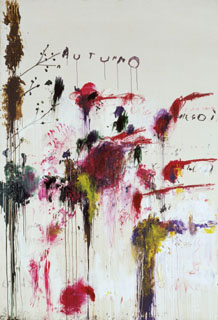It is the early 1950s and the young Cy Twombly has just got back to New York from a trip to North Africa with his friend Robert Rauschenberg. Abstract Expressionism is the new American style of the moment – the vivid drips and spills of Jackson Pollock, the glimmering fields of Mark Rothko. But at twenty-three years old, Twombly is just as fascinated by the delicate biomorphic figures painted by the Armenian emigre Arshile Gorky, and by the new European art that he goes to see every day in the art galleries on Manhattan’s West 57th Street: the pinched, attenuated figures of Giacommetti; the ad hoc sculptures of Picasso, formed from such things as the handlebars of a bicycle; the dream-like scrawls of Paul Klee; the rough-and-ready figurative canvases, inspired by cave paintings, created by Jean Dubuffet and his partners in the Parisian movement known as art brut.
Twombly’s own art of the time reflects the eclecticism of his interests. Adopting the monochrome colour schemes favoured by a number of the Abstract Expressionists, he paints canvases that resemble urban graffiti, like dark scribble on dirty cream walls. He gives them titles such as Quarzazat and Tiznit, names borrowed from the North African towns that he has so recently visited. He also makes small, ramshackle sculptures like fragile totems or votive objects, using pieces of wood tied together with twine. Untitled of 1953 is a pan pipe made from tiny spars of whitewashed wood bound together with bandages, into which nails have been hammered at variously wonky angles. It is a thing of frail beauty that seems to contain, within it, the knowingly hopeless dream of being able to re-enchant the world – a fool’s instrument left out in the hope that Apollo might return to...


